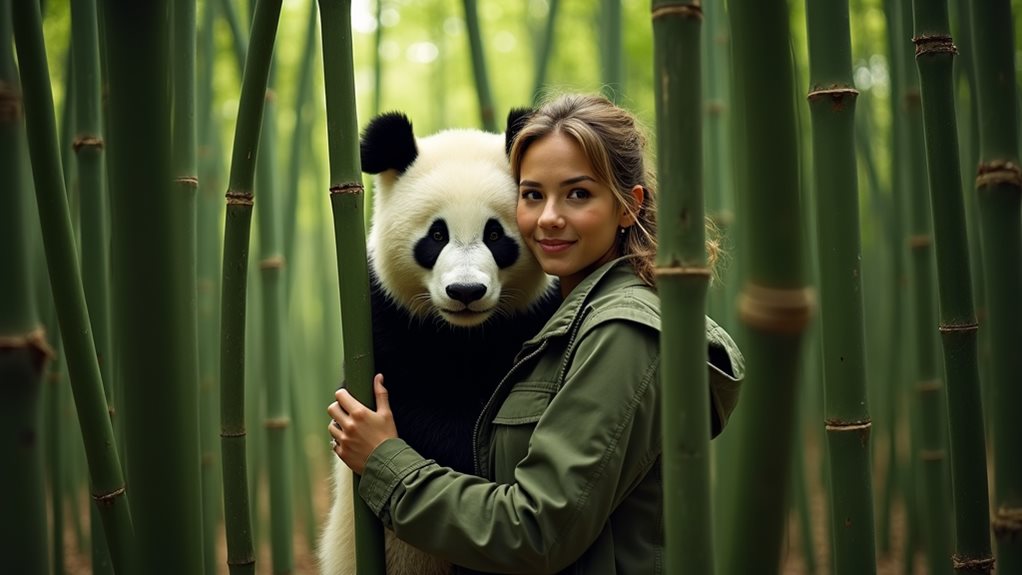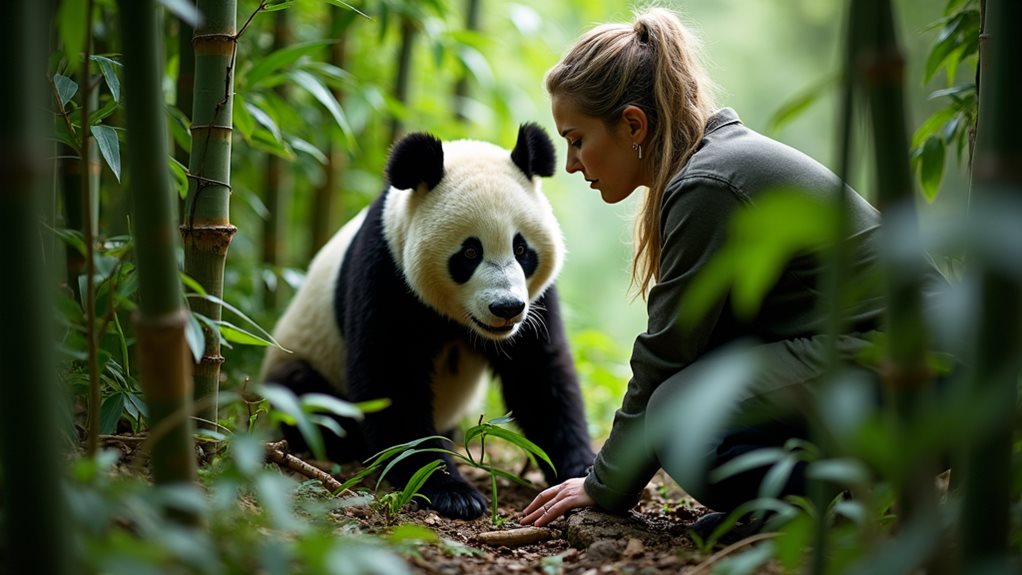
Lisa's expedition into dense bamboo thickets documented the hidden stealth of pandas, highlighting their adaptive camouflage that melds dark patches with shadowy undergrowth and white fur that catches light, aiding undetectability in their natural habitat. This research underscores the panda's agility and silent movement, essential for evading predators and ambushing prey. The discoveries contribute greatly to conservation strategies, assisting in the formulation of better protections for these stealthy inhabitants, with further exploration promising to reveal more intricate behavioral insights.
Key Takeaways
- Lisa's observations highlight the panda's natural camouflage in bamboo forests, aiding its stealth.
- She notes the panda's agility and quiet movement, crucial for survival.
- Her findings emphasize the importance of habitat conservation for panda protection.
- Research from her journey aids in refining wildlife conservation strategies.
- Lisa's work promotes educational outreach and collaborative conservation efforts.
Encounter in the Bamboo: Lisa Discovers the Invisible Panda

Nestled within the dense bamboo thickets, Lisa's initial encounter with the elusive invisible panda showcased a masterful example of natural camouflage.
This wildlife observation in the heart of bamboo ecosystems highlighted the intricate interplay between animal adaptation and habitat. The panda's ability to blend seamlessly into the surroundings is a reflection of evolutionary strategies developed over millennia.
Such observations are vital for understanding the dynamics of predator-prey interactions and the ecological balance within these environments.
Lisa's meticulous documentation contributes to our broader scientific knowledge, emphasizing the significance of preserving these natural habitats for future biodiversity studies.
Unraveling the Mystery: How Pandas Camouflage Themselves
While the mechanism behind the panda's camouflage may seem mystical, it is in fact a sophisticated evolutionary adaptation.
The distinctive black and white fur of the panda serves more than aesthetic value; it is a natural adaptation finely tuned for survival.
In dense bamboo forests, the dark patches blend with the shadowy undergrowth, while the white fur mirrors the fleeting light streaming through the canopy.
This dual-toned camouflage technique allows pandas to remain nearly invisible to both predators and prey, securing them a strategic advantage in their natural habitat.
The effectiveness of this method showcases nature's ingenuity in species preservation.
Agile Predators: The Stealth and Movement of Pandas

Pandas exhibit remarkable agility and stealth that belies their cumbersome appearance. Despite their size, these creatures navigate the dense bamboo forests with a natural grace, utilizing their black and white fur for effective camouflage.
Scientific analysis reveals that panda agility is not just about physical prowess but also involves strategic stealth techniques. These animals employ a variety of movements that minimize noise and maximize sudden, unexpected motions to evade detection.
Their ability to climb swiftly and move silently through their habitat highlights their evolved adaptations for survival. Such stealth not only aids in avoiding predators but also in surprising prey.
The Role of Conservation in Protecting Stealthy Creatures
As stealthy creatures like pandas increasingly face threats from habitat destruction and poaching, the role of conservation efforts becomes vital in their protection.
Conservation strategies that focus on habitat preservation and anti-poaching measures are significant. These efforts are complemented by scientific research into the pandas' stealth adaptation, understanding how their natural camouflage and behavior contribute to their survival.
This detailed knowledge aids in crafting targeted conservation policies that address the specific needs of these elusive animals.
Furthermore, effective conservation requires continuous monitoring and adaptation of strategies to guarantee the long-term sustainability of populations and the ecosystems they inhabit.
Lisa's Impact on Wildlife Conservation Initiatives

Lisa's journey through dense bamboo thickets, observing pandas in their natural environment, has greatly influenced wildlife conservation initiatives. Her observations have catalyzed enhanced awareness campaigns and community engagement. Scientifically, her data on panda behavior and habitat requirements have refined conservation strategies.
| Aspect | Impact on Conservation | Community Involvement |
|---|---|---|
| Habitat Monitoring | Improved management | Increased volunteerism |
| Educational Outreach | Raised awareness | Educational workshops |
| Policy Advocacy | Informed policymaking | Public consultations |
| Research Opportunities | Data-driven decisions | Collaboration with universities |
This integration of community and science fosters a robust approach to preserving the elusive panda and its habitat.
Frequently Asked Questions
What Specific Diet Supports the Panda's Stealth Abilities?
The panda's diet, mainly bamboo, supports its stealth abilities by providing essential nutrients that enhance muscle flexibility and energy for silent movement. The bamboo benefits their nutritional balance, vital for effective camouflage in habitats.
How Do Pandas Communicate Without Compromising Their Camouflage?
Pandas employ low-frequency vocalizations and extensive scent marking to communicate while maintaining camouflage. These subtle methods guarantee they remain unseen, blending seamlessly into their environment without alerting predators or prey.
Are There Known Predators of the Invisible Panda?
Invisible pandas face few natural predators due to their camouflage and stealth adaptations. Predatory behaviors are less effective against these pandas, enhancing their survival in dense bamboo forests where visibility is naturally limited.
What Are the Genetic Variations Between Visible and Invisible Pandas?
Genetic variations between visible and invisible pandas involve specific mutations affecting fur coloration and texture, enhancing stealth adaptations. These genetic differences are essential for effective camouflage, aiding in predator evasion and habitat blending.
How Does Weather Affect Panda's Camouflage Effectiveness?
Weather patterns and seasonal changes can alter the effectiveness of a panda's camouflage by affecting the density and color of the bamboo habitat, thereby influencing the visual concealment against predators and observers.
Conclusion
Lisa's journey into the bamboo thickets has peeled back the veil on the invisible panda, illustrating the adage, "Nature does not hurry, yet everything is accomplished." Her observations underscore the panda's evolutionary mastery of camouflage, a critical survival strategy in the wild. This detailed exploration not only advances our scientific understanding but also fortifies the imperative for habitat conservation. Ultimately, safeguarding these stealthy creatures guarantees the preservation of biodiversity and the intricate balance of our ecosystems.





